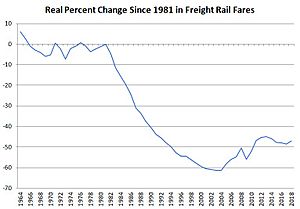Staggers Rail Act facts for kids
 |
|
| Long title | A bill to reform the economic regulation of railroads, and for other purposes. |
|---|---|
| Enacted by | the 96th United States Congress |
| Effective | October 14, 1980 |
| Citations | |
| Public law | Pub.L. 96-448 |
| Legislative history | |
|
|

The Staggers Rail Act of 1980 is a U.S. federal law. It greatly changed how the American railroad industry was controlled. This law removed many old rules that had been in place since 1887.
Contents
Why Did Railroads Need New Rules?
The Decline of Railroads
After the Great Depression and World War II, many railroads struggled. They faced tough competition from new highways and airlines. More people started using cars, which led to fewer passenger trains.
Trucking companies became major rivals by the 1930s. As the highway system grew, trucks took over more of the cargo business. Railroads were still controlled by the Interstate Commerce Commission (ICC). This group had a very complex system for setting shipping prices.
First Steps Towards Change: The 4R Act
In 1976, Congress passed the Railroad Revitalization and Regulatory Reform Act. People often called it the "4R Act." This law was the first step to reduce federal control over railroads. It also helped create Conrail, a new railroad system in the northeastern U.S.
The 4R Act allowed railroads more freedom to set prices. They could also make special deals for services. However, the ICC didn't fully put these new rules into action at first.
Why More Changes Were Needed
From 1976 to 1979, some changes did start to happen. Railroads began to support having more freedom to set their own prices. Major companies that used railroads also wanted more flexibility. They believed that custom agreements would be better for both them and the railroads. This led to the idea for a second, bigger law.
What Did the Staggers Act Do?
The Staggers Act made big changes to how railroads were regulated. Here are the main points:
- Setting Prices: Railroads could set almost any price for their services. The ICC could only step in if there was no real competition for those services.
- Contracts: Railroads and shippers could make private contracts. The ICC rarely reviewed these contracts.
- Fairness in Pricing: The law greatly limited the ICC's power to stop "discrimination" in prices among different shippers.
- Industry-Wide Price Hikes: The old system of raising prices across the entire industry was stopped.
- Teamwork on Prices: Railroads were no longer allowed to work together to set prices for routes they could handle on their own.
The Act also had rules about railroads sharing facilities. For example, it dealt with "reciprocal switching" (moving cars between different railroads) and trackage rights (one railroad using another's tracks). However, these parts of the law had less impact than the others.
Who Was Harley Staggers?
The Staggers Act was named after Harley Staggers. He was a U.S. Representative from West Virginia. He was the chairman of the House Committee on Energy and Commerce, which helped create the law.
How Did the Staggers Act Help?
Studies showed that the Staggers Act greatly helped both railroads and the companies that used them.
- Lower Costs and Prices: Over ten years, railroad costs and prices were cut in half.
- More Traffic: Railroads started to gain back business from the trucking industry.
- Better Profits: After many years of low profits and railroads going out of business, the industry began to recover.
In 2007, the Government Accountability Office told Congress that the freight rail industry was much healthier. They noted that rail rates had generally gone down since 1985. The Association of American Railroads said that average shipping rates dropped by 51 percent. They also reported that the industry invested $480 billion back into their rail systems.
Other Laws That Changed Transportation
The Staggers Act was one of three major laws passed around that time to reduce government control over transportation. These efforts began in 1971. The other two important laws were the Airline Deregulation Act of 1978 and the Motor Carrier Act of 1980.
These laws basically ended nearly a century of detailed rules that started with the ICC in 1887. The Interstate Commerce Commission Termination Act of 1995 later got rid of the ICC completely. It created a new agency called the Surface Transportation Board, which is part of the United States Department of Transportation.


